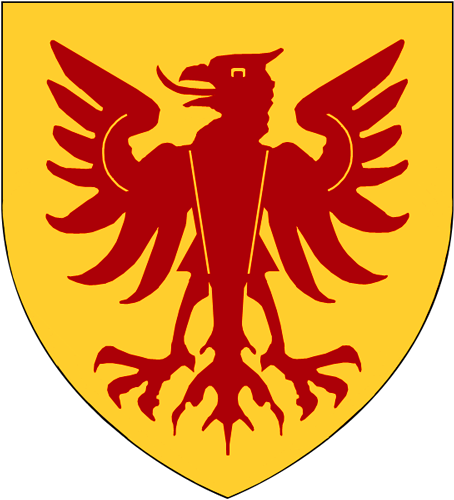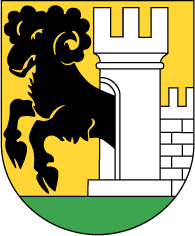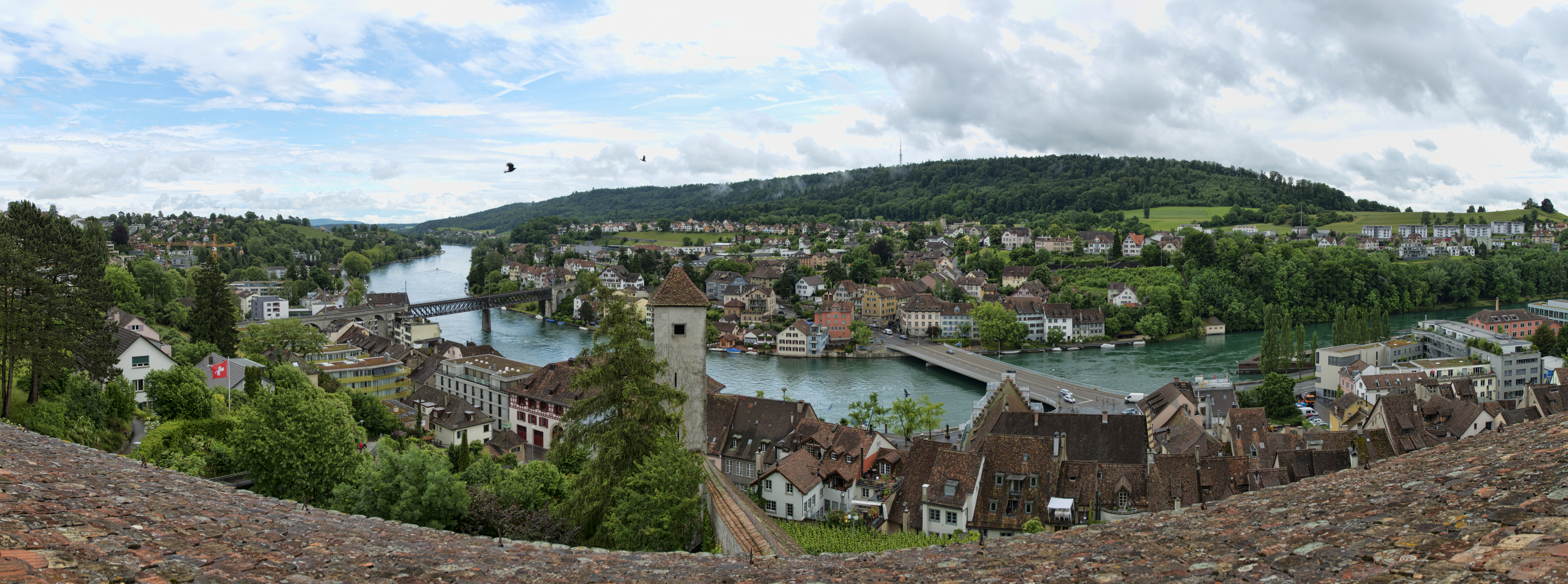|
Roundel (fortification)
The roundel is an artillery fortification with a rounded or circular plan of a similar height to the adjacent defensive walls. If the fortification is clearly higher than the walls it is called a battery tower. Design The design of a roundel, which was massive in comparison with a normal defensive tower, enabled the deployment of heavy cannon. Roundels were built of both earth and brickwork; in the latter case, vaulted rooms (casemates) were built on the inside. History Emergence Roundels appeared in the 15th century when cannon gradually developed into an effective siege weapon. Roundels are the oldest permanent artillery fortifications. Their heyday was in the 15th and early 16th centuries. Early examples of artillery roundels are in the town fortifications of Tábor before 1433 and Sion Castle, that around 1426/27, and certainly before the siege of 1437 were modified. Other early central European examples that have survived include roundels at Sigmundskron Castle near ... [...More Info...] [...Related Items...] OR: [Wikipedia] [Google] [Baidu] |
Tour
Tour or Tours may refer to: Travel * Tourism, travel for pleasure * Tour of duty, a period of time spent in military service * Campus tour, a journey through a college or university's campus * Guided tour, a journey through a location, directed by a guide * Walking tour, a visit of a historical or cultural site undertaken on foot Entertainment * Concert tour, a series of concerts by an artist or group of artists in different locations * Touring theatre, independent theatre that travels to different venues Sports * Professional golf tours, otherwise unconnected professional golf tournaments * Tennis tour, tennis played in tournament format at a series of venues * Events in various sports named the Pro Tour (other) * Tour de France ('), the world's biggest bicycle race Places * Tour-de-Faure, Lot, France * Tour-en-Bessin, Calvados, France * Tour-en-Sologne, Loir-et-Cher, France * Tours, Indre-et-Loire, France * Tours-en-Savoie, Savoie, France * Tours-en-Vimeu, Somme, Fra ... [...More Info...] [...Related Items...] OR: [Wikipedia] [Google] [Baidu] |
Marburg Castle
The Marburger Schloss (or ''Marburg castle''), also known as Landgrafenschloss Marburg, is a castle in Marburg, Hesse, Germany, located on top of Schlossberg (287 m NAP). Built in the 11th century as a fort, it became the first residence of Landgraviate of Hesse ( HRE). The Marburg Colloquy was held here in 1529. Today the building is used as a museum (Marburger Universitätsmuseum für Kulturgeschichte, Wilhelmsbau, since 1981) Philipps-Universität Marburg, Das Marburger Landgrafenschloss. Retrieved 2012-05-20. and as an event site. Location The castle is located West of Marburg, Hesse, Germany, on top of Schlossberg ("Castle Hill"). History of t ...
|
Rothenburg Ob Der Tauber
Rothenburg ob der Tauber () is a town in the district of Ansbach of Mittelfranken (Middle Franconia), the Franconia region of Bavaria, Germany. It is well known for its well-preserved medieval old town, a destination for tourists from around the world. It is part of the popular Romantic Road through southern Germany. Today it is one of only three towns in Germany that still have completely intact city walls, the other two being Nördlingen and Dinkelsbühl, both also in Bavaria. Rothenburg was a free imperial city from the late Middle Ages to 1803. In 1884 Johann Friedrich (von) Hessing (1838–1918) built ''Wildbad Rothenburg o.d.T.'' 1884–1903. Name The name "Rothenburg ob der Tauber" is German for "Red castle above the Tauber". This is so because the town is located on a plateau overlooking the Tauber River. As to the name "Rothenburg", some say it comes from the German words ''rot'' (red) and ''burg'' (burgh, medieval fortified settlement), referring to the red color of t ... [...More Info...] [...Related Items...] OR: [Wikipedia] [Google] [Baidu] |
Nuremberg
Nuremberg ( ; german: link=no, Nürnberg ; in the local East Franconian dialect: ''Nämberch'' ) is the second-largest city of the German state of Bavaria after its capital Munich, and its 518,370 (2019) inhabitants make it the 14th-largest city in Germany. On the Pegnitz River (from its confluence with the Rednitz in Fürth onwards: Regnitz, a tributary of the River Main) and the Rhine–Main–Danube Canal, it lies in the Bavarian administrative region of Middle Franconia, and is the largest city and the unofficial capital of Franconia. Nuremberg forms with the neighbouring cities of Fürth, Erlangen and Schwabach a continuous conurbation with a total population of 800,376 (2019), which is the heart of the urban area region with around 1.4 million inhabitants, while the larger Nuremberg Metropolitan Region has approximately 3.6 million inhabitants. The city lies about north of Munich. It is the largest city in the East Franconian dialect area (colloquially: "F ... [...More Info...] [...Related Items...] OR: [Wikipedia] [Google] [Baidu] |
Imperial City
In the Holy Roman Empire, the collective term free and imperial cities (german: Freie und Reichsstädte), briefly worded free imperial city (', la, urbs imperialis libera), was used from the fifteenth century to denote a self-ruling city that had a certain amount of autonomy and was represented in the Imperial Diet. An imperial city held the status of Imperial immediacy, and as such, was subordinate only to the Holy Roman Emperor, as opposed to a territorial city or town (') which was subordinate to a territorial princebe it an ecclesiastical lord ( prince-bishop, prince-abbot) or a secular prince (duke ('), margrave, count ('), etc.). Origin The evolution of some German cities into self-ruling constitutional entities of the Empire was slower than that of the secular and ecclesiastical princes. In the course of the 13th and 14th centuries, some cities were promoted by the emperor to the status of Imperial Cities ('; '), essentially for fiscal reasons. Those cities, which had b ... [...More Info...] [...Related Items...] OR: [Wikipedia] [Google] [Baidu] |
Bielefeld
Bielefeld () is a city in the Ostwestfalen-Lippe Region in the north-east of North Rhine-Westphalia, Germany. With a population of 341,755, it is also the most populous city in the administrative region (''Regierungsbezirk'') of Detmold and the 18th largest city in Germany. The historical centre of the city is situated north of the Teutoburg Forest line of hills, but modern Bielefeld also incorporates boroughs on the opposite side and on the hills. The city is situated on the ', a hiking trail which runs for 156 km along the length of the Teutoburg Forest. Bielefeld is home to a significant number of internationally operating companies, including Dr. Oetker, Gildemeister and Schüco. It has a university and several technical colleges ('' Fachhochschulen''). Bielefeld is also famous for the Bethel Institution, and for the Bielefeld conspiracy, which satirises conspiracy theories by claiming that Bielefeld does not exist. This concept has been used in the town's marketing ... [...More Info...] [...Related Items...] OR: [Wikipedia] [Google] [Baidu] |
Sparrenburg
Sparrenberg Castle, also known as the Sparrenburg (german: Burg und Festung Sparrenberg or ''Sparrenburg''), is a restored fortress in the Bielefeld-Mitte district of Bielefeld, Germany. It is situated on the Sparrenberg hill ( altitude) in the Teutoburg Forest and towers above the city centre. Its current appearance mainly originated in the 16th and 19th century. The Sparrenburg is considered to be Bielefeld's landmark. History First centuries The Sparrenburg was erected as a castle sometime before 1250 by the counts of Ravensberg.Castle description in English accessed 4 November 2019 It guarded the Bielefeld Pass over the Teutoburg Forest, as well as acting as the ruling seat of the counts of Ravensberg, and as protection for the city of Bielefeld, probably founded around 1200. Because the construction of a protective ... [...More Info...] [...Related Items...] OR: [Wikipedia] [Google] [Baidu] |
Solothurn
Solothurn ( , ; french: Soleure ; it, Soletta ; rm, ) is a List of towns in Switzerland, town, a Municipalities of Switzerland, municipality, and the Capital (political), capital of the canton of Solothurn in Switzerland. It is located in the north-west of Switzerland on the banks of the Aare and on the foot of the Weissenstein Jura mountains. The town is the only municipalities of Switzerland, municipality of the Solothurn (district), district of the same name. The town got its name from Salodurum, a Roman-era settlement. From 1530 to 1792 it was the seat of the France, French ambassador (diplomacy), ambassador to Switzerland. The pedestrian-only old town was built between 1530 and 1792 and shows an impressive array of Baroque architecture, combining Italian Grandezza, French style, and Swiss ideas. The town has eighteen structures listed as heritage sites. The official language of Solothurn is (the Swiss variety of Standard) Swiss Standard German, German, but the main spoken ... [...More Info...] [...Related Items...] OR: [Wikipedia] [Google] [Baidu] |
Celle
Celle () is a town and capital of the district of Celle, in Lower Saxony, Germany. The town is situated on the banks of the river Aller, a tributary of the Weser, and has a population of about 71,000. Celle is the southern gateway to the Lüneburg Heath, has a castle ('' Schloss Celle'') built in the Renaissance and Baroque style and a picturesque old town centre (the ''Altstadt'') with over 400 timber-framed houses, making Celle one of the most remarkable members of the German Timber-Frame Road. From 1378 to 1705, Celle was the official residence of the Lüneburg branch of the dukes of Brunswick-Lüneburg ( House of Welf) who had been banished from their original ducal seat by its townsfolk. Geography The town of Celle lies in the glacial valley of the Aller, about northeast of Hanover, northwest of Brunswick and south of Hamburg. With 71,000 inhabitants it is, next to Lüneburg, the largest Lower Saxon town between Hanover and Hamburg. Expansion The town covers ... [...More Info...] [...Related Items...] OR: [Wikipedia] [Google] [Baidu] |
Schaffhausen
Schaffhausen (; gsw, Schafuuse; french: Schaffhouse; it, Sciaffusa; rm, Schaffusa; en, Shaffhouse) is a list of towns in Switzerland, town with historic roots, a municipalities of Switzerland, municipality in northern Switzerland, and the capital of the canton of Schaffhausen, canton of the same name; it has an estimated population of 36,000 It is located right next to the shore of the High Rhine; it is one of four Swiss towns located on the northern side of the Rhine, along with , the historic , and . The old town has many fine Renaissance era buildings decorated with exterior frescos and sculpture, as well as the old canton fortress, the ''Munot''. Schaffhausen is also a railway junction of Swiss and German rail networks. One of the lines connects the town with the nearby Rhine Falls in , Europe's largest waterfall, a tourist attraction. The official language of Schaffhausen is (the Swiss variety of Standard) Swiss Standard German, German, but the main spoken language ... [...More Info...] [...Related Items...] OR: [Wikipedia] [Google] [Baidu] |
Munot
The Munot is a circular 16th century fortification in the center of the Swiss city of Schaffhausen. It is surrounded by vineyards and serves as the city's symbol. The ring-shaped fortress was built in the 16th century. Today, it is a tourist attraction and hosts various events. Earliest presence of a castle dates to 1379. The current complex was built between 1564 and 1589 under the city master builder Heinrich Schwarz (1526–1593), probably to the knowledge of Albrecht Dürer Albrecht Dürer (; ; hu, Ajtósi Adalbert; 21 May 1471 – 6 April 1528),Müller, Peter O. (1993) ''Substantiv-Derivation in Den Schriften Albrecht Dürers'', Walter de Gruyter. . sometimes spelled in English as Durer (without an umlaut) or Due ...'s work of a circular fortification. It is one of the few examples of the transition from a castle to a modern Fortress. The Munot was part of the city fortifications. The construction cost the city 47,528 guilders, which corresponded to the construction cos ... [...More Info...] [...Related Items...] OR: [Wikipedia] [Google] [Baidu] |









